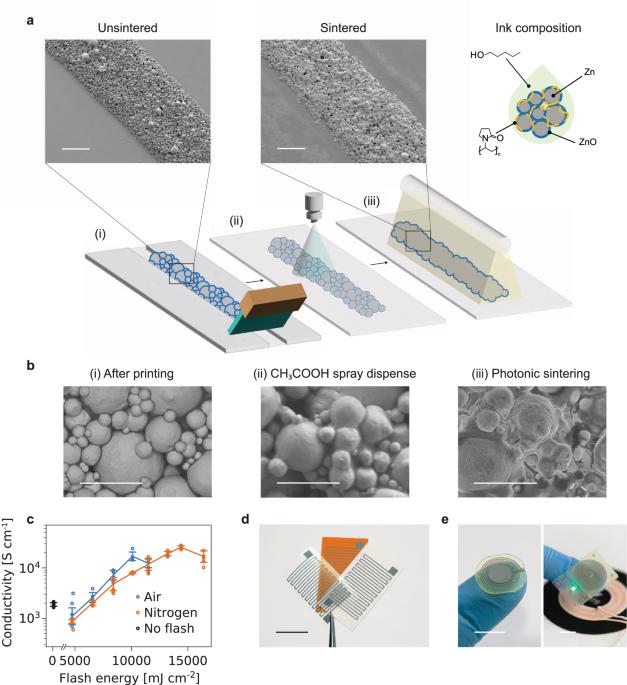用于印刷瞬态传感器和无线电子器件的锌混合烧结
IF 12.3
1区 材料科学
Q1 ENGINEERING, ELECTRICAL & ELECTRONIC
引用次数: 5
摘要
瞬态电子学为减少电子垃圾和用于植入式生物电子学提供了一种前景广阔的解决方案,但其制造仍具有挑战性。我们报告了一种可扩展的方法,该方法将化学和光子机制协同结合,烧结出印刷锌微粒。在使用酸性溶液还原氧化层后,使用闪光灯退火处理将锌颗粒聚集成一个连续的层。烧结后的锌图案显示出高达 5.62 × 106 S m-1 的导电率。印刷锌迹线的导电性和耐用性使得可生物降解传感器和 LC 电路的制造成为可能:温度、应变和无芯片无线力传感器,以及用于远程供电的射频感应线圈。该工艺可减少传送到基底的光子能量,并与对温度敏感的聚合物和纤维素基底兼容,从而为生物可降解电子器件和瞬态植入物的增材制造开辟了新途径。本文章由计算机程序翻译,如有差异,请以英文原文为准。


Zinc hybrid sintering for printed transient sensors and wireless electronics
Transient electronics offer a promising solution for reducing electronic waste and for use in implantable bioelectronics, yet their fabrication remains challenging. We report on a scalable method that synergistically combines chemical and photonic mechanisms to sinter printed Zn microparticles. Following reduction of the oxide layer using an acidic solution, zinc particles are agglomerated into a continuous layer using a flash lamp annealing treatment. The resulting sintered Zn patterns exhibit electrical conductivity values as high as 5.62 × 106 S m−1. The electrical conductivity and durability of the printed zinc traces enable the fabrication of biodegradable sensors and LC circuits: temperature, strain, and chipless wireless force sensors, and radio-frequency inductive coils for remote powering. The process allows for reduced photonic energy to be delivered to the substrate and is compatible with temperature-sensitive polymeric and cellulosic substrates, enabling new avenues for the additive manufacturing of biodegradable electronics and transient implants.
求助全文
通过发布文献求助,成功后即可免费获取论文全文。
去求助
来源期刊

npj Flexible Electronics
Multiple-
CiteScore
17.10
自引率
4.80%
发文量
91
审稿时长
6 weeks
期刊介绍:
npj Flexible Electronics is an online-only and open access journal, which publishes high-quality papers related to flexible electronic systems, including plastic electronics and emerging materials, new device design and fabrication technologies, and applications.
 求助内容:
求助内容: 应助结果提醒方式:
应助结果提醒方式:


